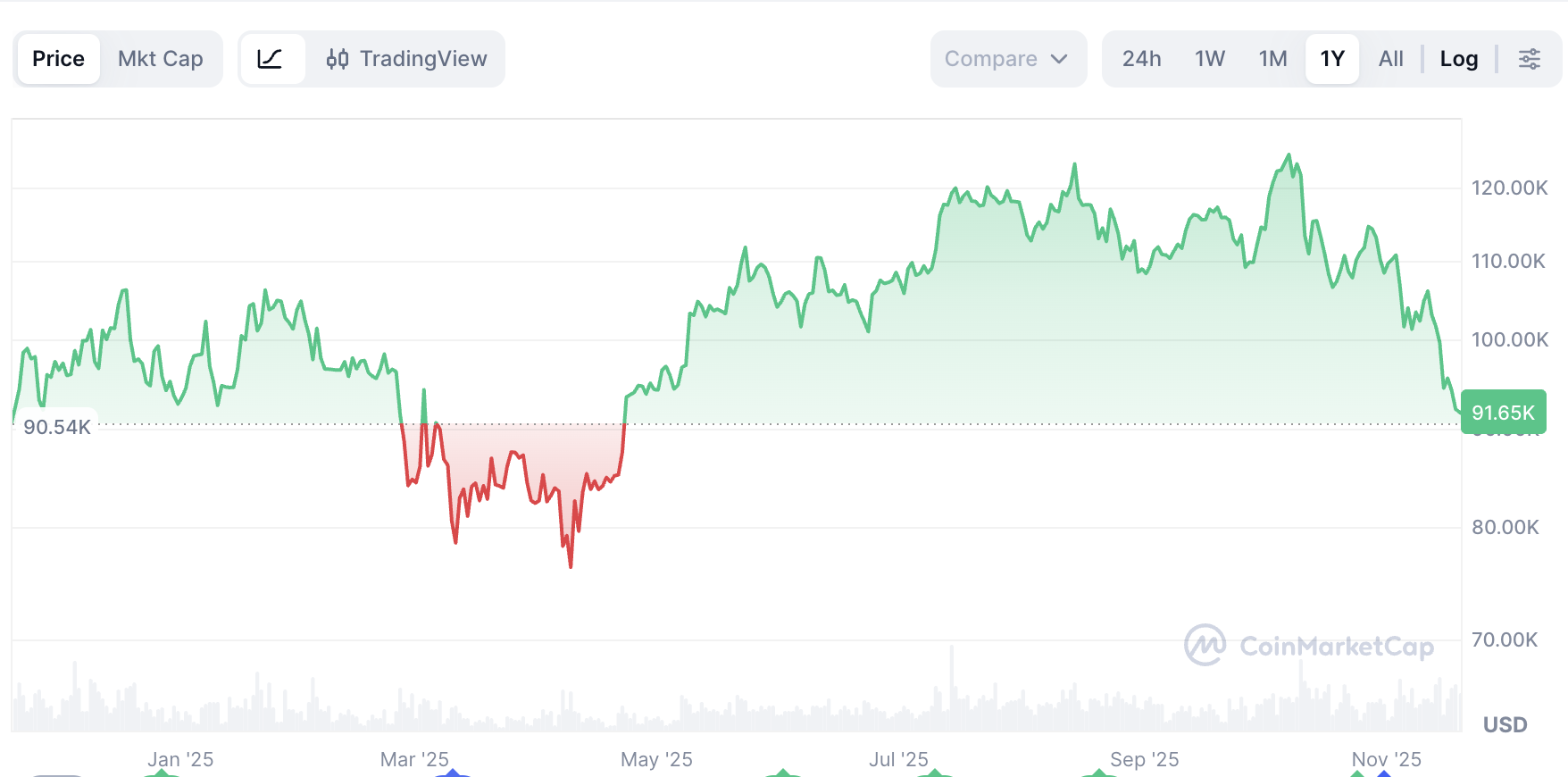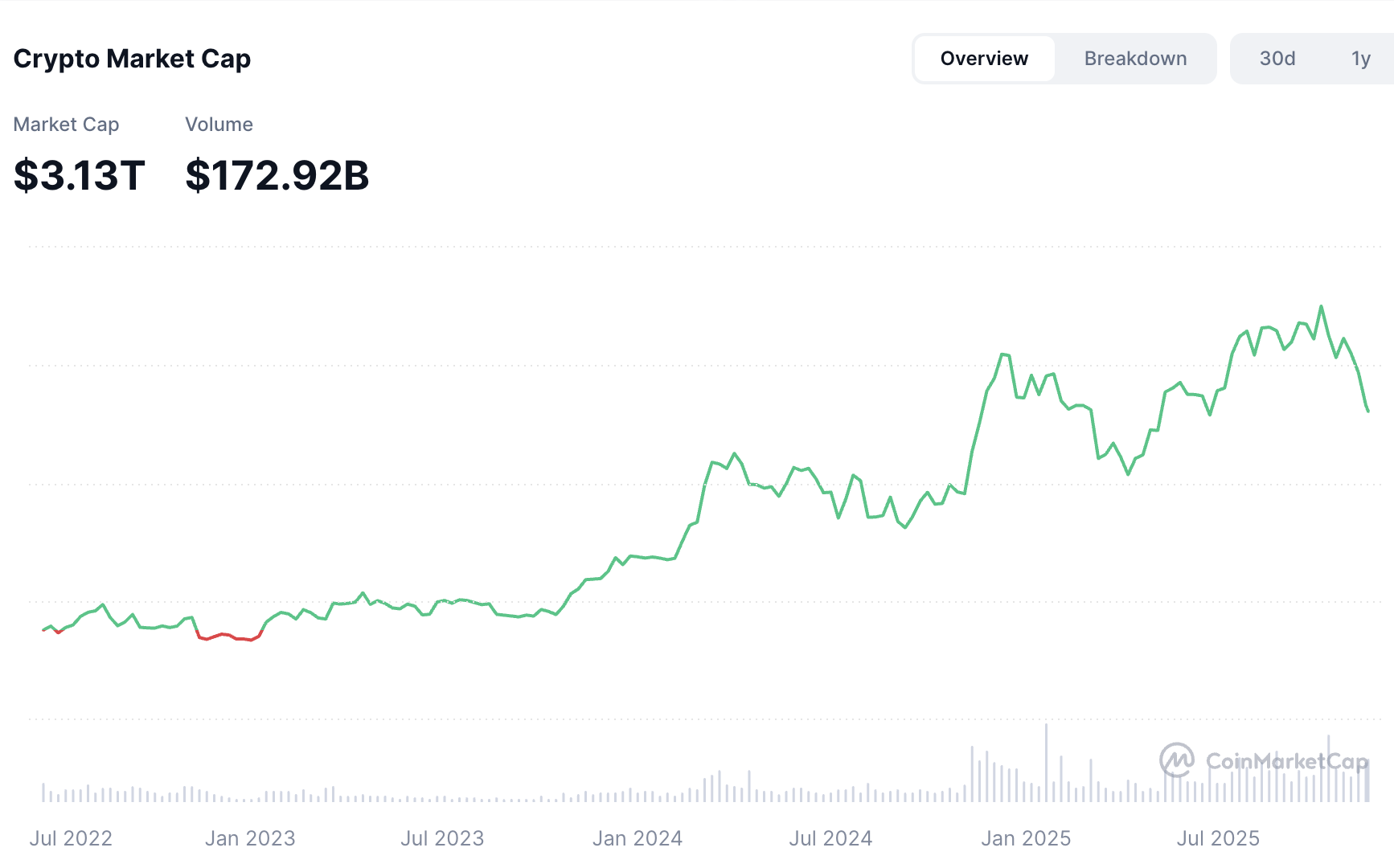Crypto Market Macro Research Report: AI Bubble, Interest Rate Repricing, and Crypto Cycle Shift
I. Macroeconomic Analysis of the Crypto Market
In the market turmoil of the past few weeks, Bitcoin's price and sentiment have shown an unusual and significant divergence: the price remains firmly above its all-time high of $90,000, but market sentiment has plunged into an abyss of "extreme fear." The Fear & Greed Index once hit 16 points, the coldest sentiment reading since the global pandemic collapse in March 2020, and even with a slight recovery recently, it has only struggled in the 12-18 range. Positive narratives about Bitcoin on social media have simultaneously plummeted, rapidly shifting from unwavering optimism to complaints, anger, and finger-pointing. This misalignment is not accidental; it often occurs in the later stages of a bull market: early entrants have already accumulated huge unrealized profits and choose to cash out at the first sign of macroeconomic uncertainty; while those who chased the highs later are quickly trapped in short-term fluctuations, and unrealized losses further amplify market panic and disappointment. Bitcoin is currently around $92,000, almost the same as at the beginning of the year ($90,500), having experienced a significant surge and deep correction throughout the year before returning to near its starting point, exhibiting a "high-level consolidation, stagnant" market trend.

On-chain fund flows provide a more direct signal than sentiment. First, the role of spot ETFs has shifted from a "booster engine" driving the bull market to a short-term "drainage pipe." Since November, ETFs have recorded a cumulative net outflow of over $2 billion, with the largest single-day outflow approaching $870 million, setting a new record for the worst performance since their listing. The impact on the narrative is far greater than the funds themselves: previously, the logic of "long-term institutional allocation" was the core support for the market, but now this support has turned into selling, making retail investors feel insecure "without institutional backing." Whale behavior also shows a clear divergence. Medium-sized whales holding 10-1000 BTC have been net sellers in the past few weeks, selling tens of thousands of Bitcoins, clearly early adopters with substantial profits choosing to cash out. Meanwhile, super whales with over 10,000 BTC have been simultaneously increasing their holdings, with on-chain data showing that some long-term strategic entities have been accumulating against the trend during the decline, amounting to tens of thousands of BTC. Meanwhile, net inflows from small-scale retail investors (≤10 BTC) are slowly increasing, indicating that while the most emotional novice users may panic and sell off, a group of more experienced long-term retail investors are seizing the opportunity to increase their positions. The on-chain realized loss indicator even saw its largest single-day loss in the past six months, with a large number of tokens being forced to sell at a loss, a clear signal of "capitulation selling." Combining various on-chain indicators, what we are seeing is not a complete market exodus, but a rapid redistribution of tokens—from short-term, emotional funds to entities with longer-term patience and stronger risk tolerance. This is a structural phenomenon that always occurs in the later stages of major bull markets. Currently, the market is in a high-level consolidation phase in the latter half of the bull market—while the market capitalization has corrected but remains on a strong platform, sentiment has cooled significantly, structural differentiation has intensified, high-quality assets are resilient, but speculative assets continue to be cleared out. The overall market capitalization of the crypto market is trending downwards.

If on-chain data and sentiment explain short-term fluctuations, then the real driving force behind this round of market trends is still macroeconomic interest rates—the real "market maker" for Bitcoin is not institutions or whales, but the Federal Reserve. In the last quarter, the market generally bet that the Fed would gradually begin a rate-cutting cycle from the second half of 2024 to early 2025. Rate cuts meant increased liquidity and higher valuations of risky assets, thus becoming a key driver of the previous rally. However, recent economic data and official statements have led to a strong repricing of this expectation. While US employment and inflation have slowed, they have not yet reached a level that can support aggressive easing; some officials have even released hawkish signals of "cautious rate cuts," causing the market to worry that interest rates may remain high for longer than originally anticipated. The cooling of rate-cutting expectations will directly reduce the discounted value of future cash flows, thereby compressing the valuations of risky assets—high-elasticity sectors such as technology growth, AI, and crypto are the first to be affected. Therefore, the recent decline is not due to a lack of new narratives in the crypto industry, but rather a direct increase in the "discount rate" of the entire risky asset universe at the macro level, representing a violent valuation downgrade.
II. The Profound Impact of the AI Bubble on the Crypto Macroeconomy
From 2023 to 2025, artificial intelligence overwhelmingly became the core force in global risk asset pricing, replacing older narratives such as "metaverse," "Web3," and "DeFi summer," and becoming the primary driver of capital market valuation expansion. Whether it was Nvidia's market capitalization surpassing one trillion dollars, OpenAI's infrastructure ambitions, or the explosive growth of super data centers and sovereign AI projects, the entire market completed a paradigm shift from "technology growth" to "AI frenzy" in just two years. However, behind this feast lies an increasingly fragile leverage structure, increasingly massive capital expenditures, and financial engineering that increasingly relies on "internal circulation." The rapid expansion of AI valuations has ironically made the entire high-risk asset system more vulnerable. Its volatility is directly and continuously transmitted to the crypto market through risk budgets, interest rate expectations, and liquidity conditions, profoundly affecting the cyclical structure and pricing framework of Bitcoin, Ethereum, and altcoins.
In institutional asset allocation systems, AI leaders have transformed from traditional growth stocks into "super technology factors," becoming the center of high-risk portfolios and even exhibiting endogenous leverage. When AI rises, risk appetite expands, naturally increasing institutional allocations to high-risk assets, including Bitcoin. Conversely, when AI experiences sharp fluctuations, valuation pressures, or credit concerns, risk budgets are forced to contract. Model-driven and quantitative trading rapidly reduce overall risk exposure, with crypto assets—the most volatile and unsupported by cash flow—often becoming the primary targets for selling. Therefore, the tug-of-war and corrections in the later stages of the AI bubble will amplify the magnitude of the crypto market's adjustment simultaneously at both the sentiment and structural levels. This was particularly evident in November 2025: when AI-related tech stocks adjusted due to financing pressures, rising credit spreads, and macroeconomic uncertainties, Bitcoin and US stocks simultaneously fell below key levels, forming a typical "cross-asset risk transmission." Besides risk appetite, the liquidity crowding-out effect is the most crucial suppressive factor of the AI bubble on the crypto market. In a macroeconomic environment of "limited capital pools," this inevitably means that the marginal capital of other high-risk assets is compressed, and cryptocurrencies become the most obvious "capital victims."
A deeper impact stems from the competition within narrative frameworks. In market sentiment and valuation construction, narrative is often just as important as fundamentals. Over the past decade, the crypto industry has gained widespread attention and substantial premiums through narratives such as decentralized finance, digital gold, and open financial networks. However, the AI narrative from 2023 to 2025 exhibits extreme exclusivity, with its grand narrative framework—"the core engine of the Fourth Industrial Revolution," "computing power is the new oil," "data centers are the new industrial real estate," and "AI models are the economic infrastructure of the future"—directly suppressing the narrative space of the crypto industry. At the policy, media, research, and investment levels, almost all attention is focused on AI, and crypto only regains its voice when global liquidity fully eases. This makes it difficult for the crypto industry to regain valuation premiums even with healthy on-chain data and an active developer ecosystem. However, when the AI bubble bursts or enters a period of deep adjustment, the fate of crypto assets may not be bleak, and they may even usher in a decisive opportunity. If the AI bubble evolves along the path of the 2000 dot-com bubble—that is, experiencing a 30%–60% valuation correction, the exit of some highly leveraged, narrative-driven companies, and tech giants cutting capital expenditures, while the overall credit system remains stable—then the short-term pain in the crypto market will be exchanged for significant medium-term gains. If the risk evolves into a credit crisis similar to 2008, although the probability is limited, the impact will be more severe. The breakdown of tech debt chains, concentrated defaults of data center REITs, and damage to bank balance sheets could all trigger "systemic deleveraging," causing cryptocurrencies to experience a waterfall-like crash similar to that of March 2020 in the short term. However, such extreme scenarios often also imply a stronger medium- to long-term rebound, as central banks will be forced to restart QE, cut interest rates, or even adopt unconventional monetary policies. Cryptocurrencies, as a tool to hedge against excessive money supply, will see a strong recovery in an environment of abundant liquidity.
In summary, the AI bubble is not the end of the crypto industry, but rather a prelude to the next major crypto cycle. During the bubble's upward phase, AI will squeeze funds, attention, and narratives away from crypto assets; conversely, during the bubble's burst or digestion, AI will release liquidity, risk appetite, and resources back into the crypto market, laying the foundation for its restart. For investors, understanding this macroeconomic transmission structure is more important than predicting prices; the emotional low point is not the end, but a crucial stage in the migration of assets from weak to strong hands; real opportunities are not found in the noise, but often emerge around the time of macroeconomic narrative shifts and liquidity cycle reversals. The next major cycle in the crypto market is highly likely to officially begin after the AI bubble recedes.
III. Opportunities and Challenges Amidst Macroeconomic Market Changes in Crypto
The global macroeconomic environment at the end of 2025 is showing structural changes that are drastically different from those of previous years. After a two-year tightening cycle, global monetary policy has finally shifted in sync. The Federal Reserve has already implemented two interest rate cuts in the second half of 2025, while confirming the formal end of quantitative tightening and halting balance sheet contraction. The market expects a new round of interest rate cuts in the first quarter of 2026. This means that global liquidity has shifted from "draining" to "supplying," M2 growth has returned to an expansionary trajectory, and the credit environment has significantly improved. For all risk assets, such cyclical turning points often signify the formation of new price anchors. For the crypto market, the timing of the global easing cycle coincides with multiple factors, including internal leverage cleansing, a market sentiment freeze, and ETF outflows bottoming out, forming the basis for 2026 potentially becoming a "restart point." While synchronized global easing is uncommon, the macroeconomic landscape of 2025-2026 exhibits a high degree of consistency. Japan launched a fiscal stimulus package exceeding $100 billion, continuing its ultra-loose monetary policy; China further strengthened its dual easing of monetary and fiscal policies under economic pressure and structural demand; and Europe, on the verge of recession, began discussing restarting quantitative easing (QE). The simultaneous implementation of easing policies by major global economies is an unprecedentedly positive factor for crypto assets in recent years. This is because crypto assets are inherently one of the most liquidity-sensitive asset classes globally, especially Bitcoin, whose valuation is highly correlated with the dollar liquidity cycle. When the world simultaneously enters an environment of "loose monetary policy + weak growth," the attractiveness of traditional assets decreases, and liquidity spillover will prioritize assets with higher beta. Crypto assets have experienced explosive growth in the past three cycles precisely under such macroeconomic conditions.
Meanwhile, the intrinsic structure of the crypto market has gradually recovered from the turmoil of 2025. Long-term holders (LTH) have not engaged in significant selling, and on-chain data shows that tokens are shifting from emotional sellers to high-conviction buyers; whales continue to accumulate during deep price declines; large-scale outflows from ETFs are primarily driven by retail panic rather than institutional withdrawal; and the funding rate in the futures market has returned to neutral or even negative territory, with leverage being completely squeezed out of the market. This combination suggests that selling pressure in the market mainly comes from weak hands, while tokens are concentrating on strong hands. In other words, the crypto market is in a position similar to Q1 2020: valuations are suppressed, but the risk structure is far healthier than it appears. However, the other side of the coin is challenges. While the easing cycle is returning, the spillover risk of the AI bubble cannot be ignored. The valuations of tech giants are approaching unsustainable levels, and if funding chains or profit expectations deviate, tech stocks may experience another sharp correction, and crypto assets, as a high-risk counterpart, will inevitably passively bear the brunt of a "systemic beta sell-off." Furthermore, Bitcoin lacks a decisive new catalyst in the short term. The ETF model of 2024-2025 has been fully traded by the market. A new narrative needs to wait for the Fed to initiate QE, for large institutions to return to increasing their holdings, and for traditional financial institutions to accelerate their deployment of crypto infrastructure. The continued outflow of ETFs reflects extreme fear among retail investors; the VIX, having fallen to an extreme value of 9, still needs time to complete its "surrender bottom," and the market needs to wait for new incremental signals. Considering the overall macroeconomic environment and market structure, from a time perspective, the crypto market will continue to fluctuate and consolidate at the bottom in Q4 2025-Q1 2026. AI bubble pressure, ETF outflows, and macroeconomic data uncertainty will jointly drive the market to maintain a weak and volatile pattern. However, with accelerated interest rate cuts and a substantial return of liquidity in the first and second quarters of 2026, BTC is expected to regain above $100,000, and in Q3-Q4 2026, with the combined effects of QE expectations, the new narrative of DePIN/HPC, and national reserve BTC, a new bull market cycle will be confirmed. This path suggests that the crypto market is transitioning from a "valuation killing phase" to a "repricing phase," and a true trend reversal requires a resonance between liquidity and narrative.
Investment strategies in this environment need to be recalibrated to cope with volatility and capture opportunities. Deferred Action for All (DCA) (DCA) strategy yields optimal statistical returns during periods of extreme fear and is the best way to hedge against short-term noise and emotional fluctuations. In terms of portfolio structure, the proportion of altcoins should be reduced, while the weighting of BTC/ETH should be increased, as altcoins experience deeper declines during periods of risk-controlled compression, and ETF accumulation mechanisms will continue to strengthen Bitcoin's relative advantage in the medium term. Given the possibility of another deep correction in tech stocks, reminiscent of an "internet bubble," investors should maintain a certain amount of emergency funds to secure optimal entry points when macroeconomic risk events trigger excessive sell-offs in crypto assets. From a long-term perspective, 2026 will be a pivotal year for the redistribution of global liquidity and the year the crypto market returns to the forefront after a structural cleansing. The true winners will be those who maintain discipline and patience during the coldest periods of sentiment.
IV. Conclusion
Considering on-chain structure, sentiment indicators, fund flows, and the global macroeconomic cycle, this round of decline resembles a sharp turnover in the latter half of a bull market rather than a structural reversal. The repricing of interest rate expectations is putting short-term valuation pressure, but the clear global easing trend, synchronized stimulus in Japan and China, and the termination of QT mean that 2026 will be a crucial year for renewed liquidity expansion. The AI bubble may continue to be a short-term drag, but its bursting or deflation will release squeezed capital and narrative space, providing new valuation support for scarce assets like Bitcoin. The market is expected to continue its consolidation and bottoming process from Q4 2025 to Q1 2026, with Q2-Q4 2026, driven by the interest rate cut cycle, becoming a trend reversal window. Disciplined DCA, increasing the weighting of BTC/ETH, and maintaining emergency positions are the optimal strategies for navigating volatility and embracing the new cycle.
- 核心观点:加密市场处于牛市后半段高位震荡期。
- 关键要素:
- 比特币价格高位震荡,情绪极度恐惧。
- ETF净流出超20亿美元,机构减仓。
- 美联储降息预期降温压制风险资产。
- 市场影响:短期承压,中长期或迎流动性驱动牛市。
- 时效性标注:中期影响



